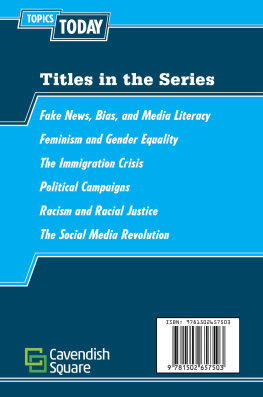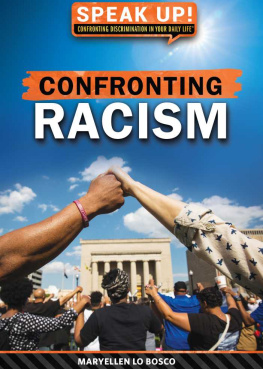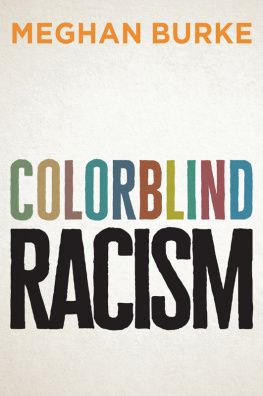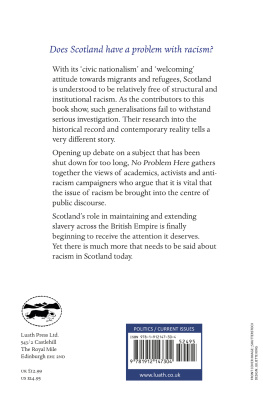Published in 2018 by
Lucent Press, an Imprint of Greenhaven Publishing, LLC
353 3rd Avenue
Suite 255
New York, NY 10010
Copyright 2018 Greenhaven Press, a part of Gale, Cengage Learning
Gale and Greenhaven Press are registered trademarks used herein under license.
All new materials copyright 2018 Lucent Press, an Imprint of Greenhaven Publishing, LLC.
All rights reserved. No part of this book may be reproduced in any form without permission in writing from the publisher, except by a reviewer.
Designer: Seth Hughes
Editor: Jennifer Lombardo
Cataloging-in-Publication Data
Names: Green, Meghan.
Title: Racism in America: a long history of hate / Meghan Green.
Description: New York : Lucent Press, 2018. | Series: Hot topics | Includes index.
Identifiers: ISBN 9781534561434 (library bound) | ISBN 9781534561441 (ebook)
Subjects: LCSH: Racism--United States--Juvenile literature. | United States--Race relations--Juvenile literature. | Race discrimination--United States--Juvenile literature.
Classification: LCC E184.A1 G74 2018 | DDC 305.800973--dc23
Printed in the United States of America
CPSIA compliance information: Batch #BS17KL: For further information contact Greenhaven Publishing LLC, New York, New York at 1-844-317-7404.
Please visit our website, www.greenhavenpublishing.com. For a free color catalog of all our high-quality books, call toll free 1-844-317-7404 or fax 1-844-317-7405.
CONTENTS
FOREWORD
INTRODUCTION
Racism Is Not New
CHAPTER 1
Modern-Day Racism
CHAPTER 2
Factors of Racism
CHAPTER 3
Racism in Society
CHAPTER 4
Combating Racism
CHAPTER 5
The Fight Continues
NOTES
DISCUSSION QUESTIONS
ORGANIZATIONS TO CONTACT
FOR MORE INFORMATION
INDEX
PICTURE CREDITS
ABOUT THE AUTHOR
FOREWORD
A dolescence is a time when many people begin to take notice of the world around them. News channels, blogs, and talk radio shows are constantly promoting one view or another; very few are unbiased. Young people also hear conflicting information from parents, friends, teachers, and acquaintances. Often, they will hear only one side of an issue or be given flawed information. People who are trying to support a particular viewpoint may cite inaccurate facts and statistics on their blogs, and news programs present many conflicting views of important issues in our society. In a world where it seems everyone has a platform to share their thoughts, it can be difficult to find unbiased, accurate information about important issues.
It is not only facts that are important. In blog posts, in comments on online videos, and on talk shows, people will share opinions that are not necessarily true or false, but can still have a strong impact. For example, many young people struggle with their body image. Seeing or hearing negative comments about particular body types online can have a huge effect on the way someone views himself or herself and may lead to depression and anxiety. Although it is important not to keep information hidden from young people under the guise of protecting them, it is equally important to offer encouragement on issues that affect their mental health.
The titles in the Hot Topics series provide readers with different viewpoints on important issues in todays society. Many of these issues, such as teen pregnancy and Internet safety, are of immediate concern to young people. This series aims to give readers factual context on these crucial topics in a way that lets them form their own opinions. The facts presented throughout also serve to empower readers to help themselves or support people they know who are struggling with many of the challenges adolescents face today. Although negative viewpoints are not ignored or downplayed, this series allows young people to see that the challenges they face are not insurmountable. Eating disorders can be overcome, the Internet can be navigated safely, and pregnant teens do not have to feel hopeless.
Quotes encompassing all viewpoints are presented and cited so readers can trace them back to their original source, verifying for themselves whether the information comes from a reputable place. Additional books and websites are listed, giving readers a starting point from which to continue their own research. Chapter questions encourage discussion, allowing young people to hear and understand their classmates points of view as they further solidify their own. Full-color photographs and enlightening charts provide a deeper understanding of the topics at hand. All of these features augment the informative text, helping young people understand the world they live in and formulate their own opinions concerning the best way they can improve it.
INTRODUCTION
Racism Is Not New
T hroughout world history, certain groups have proclaimed that lighter skin is better than darker skin. White Europeans, most notably the Vikings, the Romans, and the British, spread across the globe in search of money and power. The impac these groups can still be seen in some countries today.
The United States was founded as a group of British colonies by white people trying to escape religious persecution in England, but the British were not the only people who lived there. Before the 1800s, the Spanish, French, and Dutch all claimed portions of what is now the United States. Each of these groups persecuted the Native Americans who were already living there when the settlers arrived; the British and Europeans took Native American lands, broke treaties, and attempted to exterminate various Native American groups.
After the United States became an independent country, this persecution persisted and affected national policy. Most notably, in the 1830s, Andrew Jackson signed legislation that eventually forced the Cherokee people to move from present-day Georgia, Tennessee, Alabama, North Carolina, and Florida to present-day Oklahoma so white people could settle and plant crops where the Cherokee had once lived. This journey was often difficult and dangerous, and many people died on the way, which led to this event being called the Trail of Tears. Today, negative attitudes regarding Native Americans and their lands still exist.
The Trail of Tears is one of the most obvious examples of racism against Native Americans, but more subtle racism still exists today.
Black people have also had an especially difficult time in the United States from the beginning of the nations history. In 1619, the first slaves were brought from Africa to the colony of Virginia. Slavery became a national institution and was responsible for much of the economic growth in the United States. Although slavery was eventually abolished, racist attitudes against black people persist throughout the country.
As time went on and people from other countries began immigrating to the United States, they, too, often faced racism when they arrived. Although people of typically white nationalities, such as the Irish and Italians, were discriminated against, this was not due to the color of their skin, and they were eventually societally accepted in the United States. However, for Arabs, Middle Easterners, Latinx, East Asians, and Southeast Asians, their skin color has made them easy targets for discrimination and sometimes violence.














